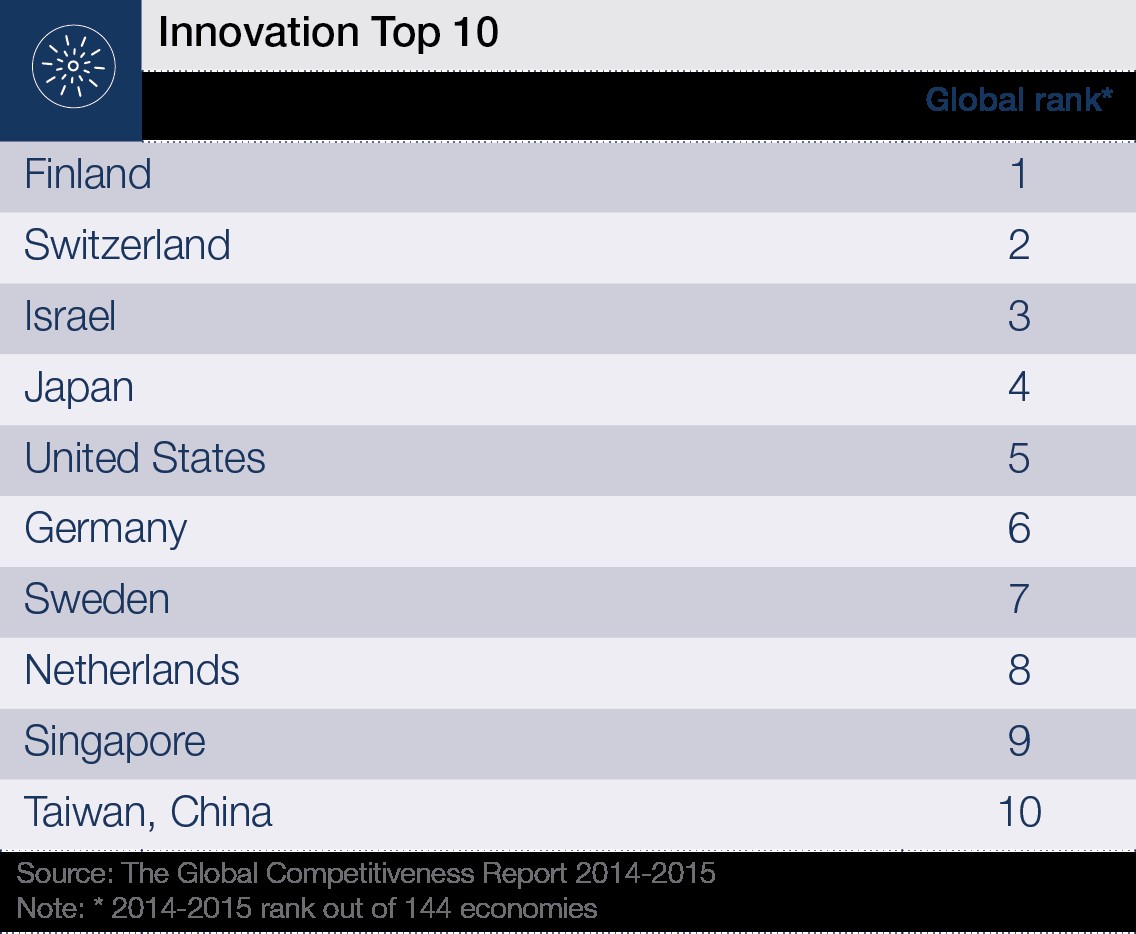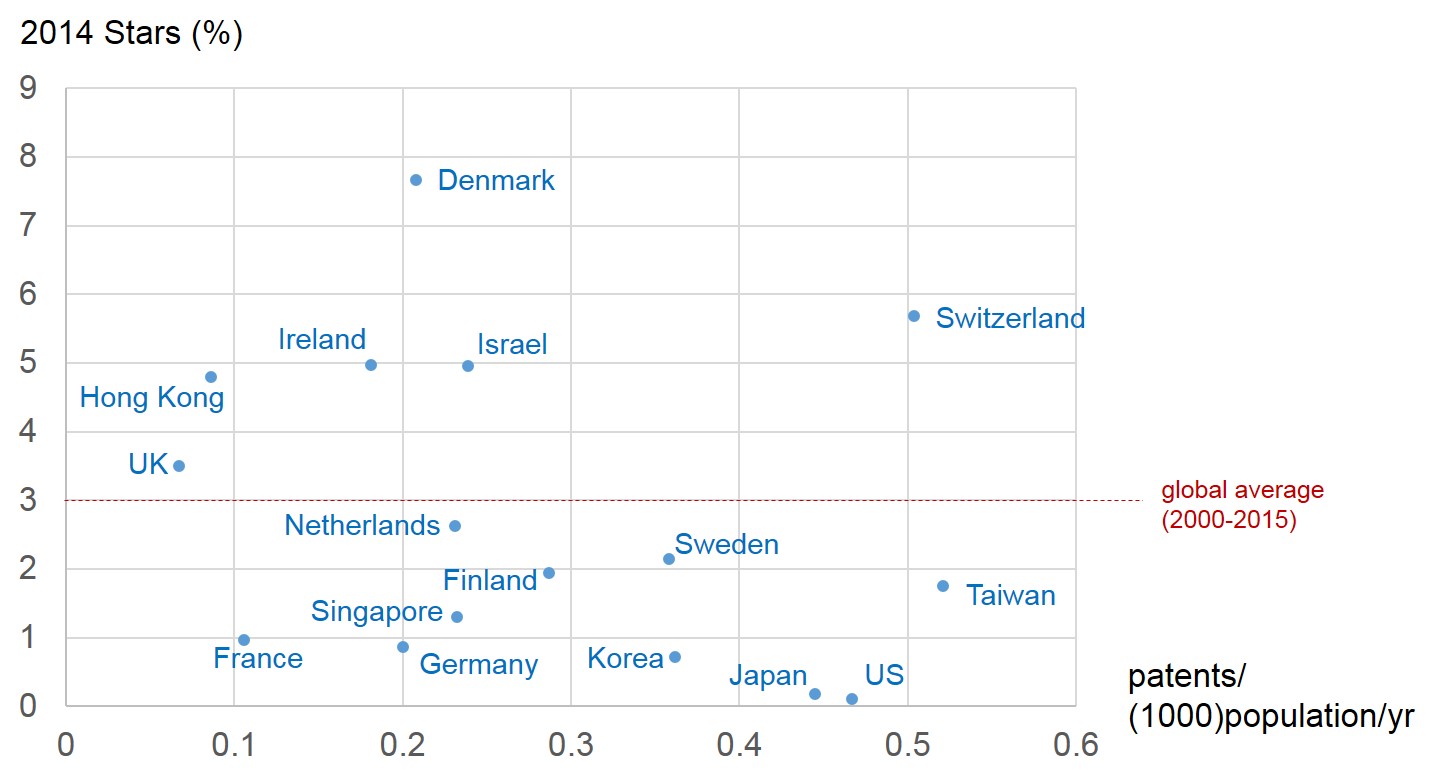Ah, the World Economic Forum. If ever an organisation epitomized the fallacy of measuring what’s easy rather than what’s important, it is this esteemed body of blinkered economists.
Joy of joys, they’ve just published the results of their annual Global Competitiveness Report. Which these days includes a specific ‘most innovative country’ section. Not that it has anything useful to tell anyone, but here is the ‘top 10’ according to the survey:
The reason the result is essentially meaningless is largely because the WEF apparently has no idea what ‘innovation’ means. According to the way the study has been conducted, it apparently has something to do with:
- The amount of money being spent on R&D by companies
- Quality of academic research institutions based on the number of citations of academic journal articles
- ‘capacity for innovation’ on a 1-7 Likert scale.
The first criterion conveniently forgets the fact that 98% of innovation attempts fail. Innovation, in other words, has almost no correlation at all with the amount of money companies throw at it. In many ways, what the WEF have unwittingly collated is a measure of innovation inefficiency.
If you thought a 98% innovation attempt failure rate was bad, things get twice as bad when we shift the focus to the academic sector. In the EU right now, on average every million Euros invested in academic research is going to deliver slightly less than 10,000 Euros back in useful return. So measuring innovativeness based on university-anything is akin to counting sheep two years after you opened all the gates.
Or maybe, to extend the metaphor a step further and look at the third WEF calculation criterion, it’s a bit like asking a random passer-by to rank your field on its sheep-iness. On a 1-7 scale. Ah yes, that pasture looks like a five. Whereas that Albanian one over there looks like a four. Not only is the analysis meaningless, there is no-one on the planet that can make any of the cross-nation comparisons in any kind of sensible fashion. So much for that idea.
Above and beyond these three ill-fitting criteria, the WEF study also builds an analysis of patents into their findings. With a mere 97% of patents never making any money for their assignees, I guess you could say that this is one of the better measures. Having a patent granted is at least some kind of indication that you have an intention to monetize a new idea. The big problem, of course, given that inconvenient 97% number, is that measuring quantity of patents can only ever be a tiny part of the story. Admittedly it’s an easy thing to measure, but, per the introduction to this diatribe, just because something is easy to do shouldn’t justify doing it. Far better in this kind of situation would have been to try and measure innovativeness using something like patent quality.
That’s what we set out to do when we built the ApolloSigma measurement method: number of patents is almost pointless, how well they’re able to be monetized and how ‘future-proof’ they are is the thing you need to be able to quantify.
When we look at the global innovativeness story through the ApolloSigma lens, looking at the ‘Star’ patents granted during the year 2014, plotted against the number of patents generated in a country per head of population, here’s what we end up with:
First thing to say looking at this picture, I guess, is ‘sorry Finland, you’re not the most innovative nation on the planet’. Depending on how we interpret the graph, you’re barely in the top 10. Whereas, neighbour Denmark is. And moreover, if we just look at the quality of patents, Denmark was, by some margin the most effective patenter on the planet last year.
Okay. So much for patents. We’re still – in most parts of the world at least – falling in to the trap of assuming that ‘innovation’ is all about science and technology. These days the definition needs to include all of the business-model step-change stories. Maybe that’s where we should look next. See what a Top Ten list looks like through that lens….


